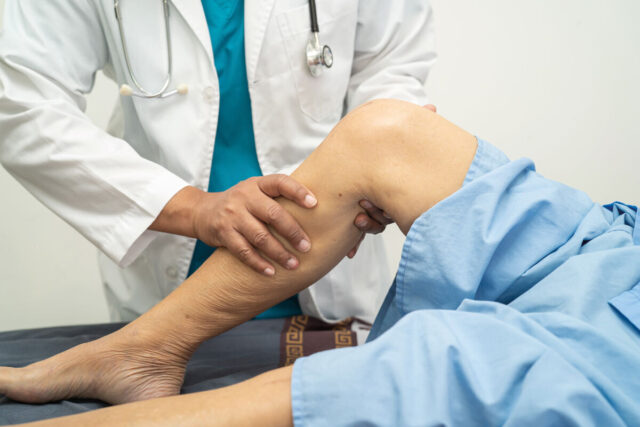Last resort for your own knee
How leg axis correction can help to preserve the knee joint for as long as possible

Many patients come to the Sportklinik Hellersen concerned that their knee joints will no longer be able to withstand the stresses and strains of everyday life. However, thanks to the high level of expertise of the medical staff and the interdisciplinary cooperation between the departments, they can be sure that an endoprosthesis will only be considered at the specialist clinic once all joint-preserving measures have been exhausted. Modern medicine makes it possible to preserve your own knee joint for as long as possible. Dr. Volker Stoll, Chief for Knee Surgery and Sports Traumatology, explains in an interview what role leg axis correction plays in this.
Photo: Hanna Witte
When is leg alignment correction necessary?
Dr. Volker Stoll: Leg axis correction gives us the opportunity to preserve the knee joint. Patients often come to us at the Sportklinik Hellersen believing that they absolutely need an artificial knee joint. However, during the examination, we often find that the knee is still largely intact and only one part, for example the inner side, is worn. The outer side is often still in good condition. In such cases, leg axis correction allows us to shift the load from the worn inner side slightly to the outside. Many patients report that they have hardly any discomfort in their everyday lives after the procedure. This differentiated treatment option is an excellent way of delaying the use of an endoprosthesis, which should always be the last resort.
Are there differences in leg axis corrections?
Dr. Volker Stoll: Yes, there are differences depending on whether a patient has bow legs or knock knees. When correcting leg alignment, it is crucial to determine exactly where the misalignment is.
In the case of bow legs, the misalignment is often located in the area of the tibial head. In such cases, the correction is performed on the tibial head. In the case of knock knees, however, the misalignment is usually located in the thigh. In this case, we perform the leg axis correction on the thigh.
Accurate diagnosis is crucial in order to tailor the procedure to the individual patient and achieve the best possible result.
Photo: Ruslan Guzov | freepik.com
“The entire process is easy to plan and in most cases leads to a significant improvement in symptoms.”
Dr. Volker Stoll
Chief of Knee Surgery and Sports Traumatology
What is the procedure and how does the operation work?
Dr. Volker Stoll: The procedure usually takes about an hour. The lower leg is sawed at the appropriate place and carefully opened up to correct the leg axis. We then fix the new position with a small, very light titanium plate, which is secured with angle-stable screws.
Once the bone cut has completely healed, the plate can usually be removed after about a year. The entire process is easy to plan and, in most cases, leads to a significant improvement in symptoms.
How quickly do patients recover after such an operation?
Dr. Volker Stoll: Patients can get up and move their knee joint on the day of the operation. However, weight-bearing is limited to a maximum of 10 kilograms for the first six weeks. After this phase, we carry out a follow-up examination. If everything has healed well, patients can gradually increase the weight they put on their knee.
Approximately 8 to 10 weeks after the procedure, you will be able to put your full weight on your knee again and move around without walking aids in everyday life. However, as the statics of the leg have changed, it is important to undergo targeted muscle-building and coordination training afterwards. Patients usually feel the greatest benefits of the operation after six to twelve months.
Before leg axis correction
After leg axis correction
Can I completely avoid an artificial joint with a leg axis correction?
Dr. Volker Stoll: Yes, that is entirely possible. Strengthening specific muscles and relieving pressure on the joint can help to significantly delay the need for a prosthesis. It is particularly important to treat the joints more gently and reduce strain as we age, as the demands placed on the joints change compared to when we are younger. However, if it becomes necessary to insert an endoprosthesis at some point, this can be done at any time. Thanks to close cooperation and intensive interdisciplinary exchange with the endoprosthetics department, individual solutions can be found. With knee prostheses, a distinction is made between a total prosthesis and a partial prosthesis, known as a sliding prosthesis. The sliding prosthesis is used when only part of the knee joint, usually the inner side, is affected by wear and tear and needs to be replaced with an artificial joint. This requires that the opposite side does not yet show advanced cartilage damage and that the cruciate ligament is intact. In these cases, partial prostheses can be used before a complete joint replacement becomes necessary. As people are living longer today, we need to develop differentiated solutions that enable patients to remain active into old age.



























